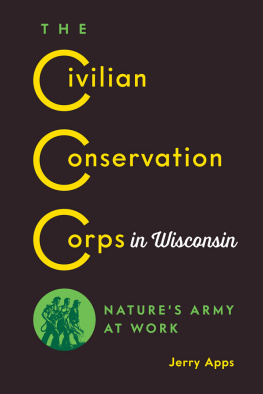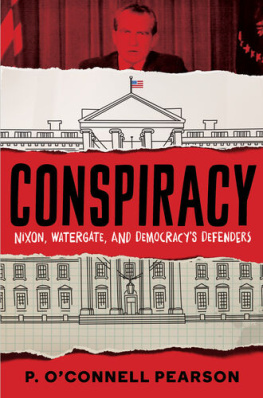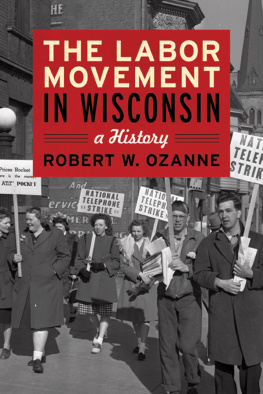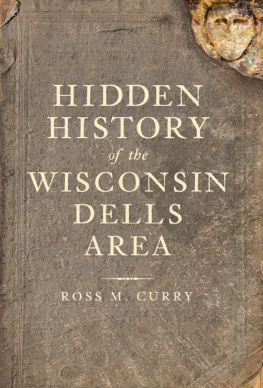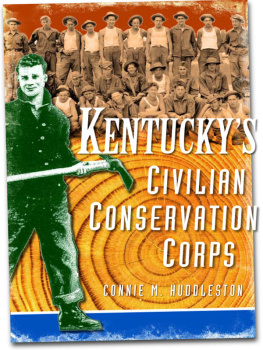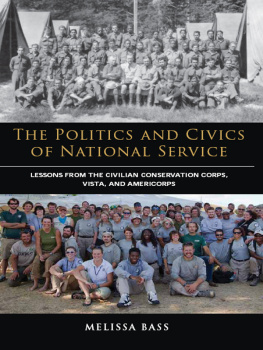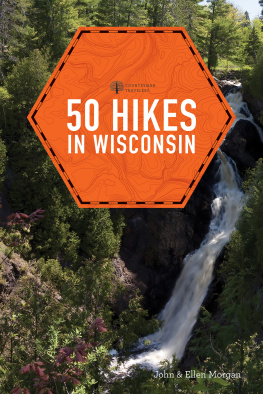

Published by The History Press
Charleston, SC 29403
www.historypress.net
Copyright 2011 by Robert J. Moore
All rights reserved
Front cover: Color photo of Devils Lake courtesy of Robert J. Moore.
First published 2011
e-book edition 2013
Manufactured in the United States
ISBN 978.1.62584.206.0
Library of Congress Cataloging-in-Publication Data
Moore, Robert, 1949-
Devils Lake, Wisconsin, and the Civilian Conservation Corps / Robert Moore.
p. cm.
Includes bibliographical references and index.
print edition ISBN 978-1-60949-277-9
1. Devils Lake State Park (Wis.)--History. 2. Civilian Conservation Corps (U.S.)--Wisconsin--Devils Lake Region--History. I. Title.
F587.S2M66 2011
977.576--dc22
2011010588
Notice: The information in this book is true and complete to the best of our knowledge. It is offered without guarantee on the part of the author or The History Press. The author and The History Press disclaim all liability in connection with the use of this book.
All rights reserved. No part of this book may be reproduced or transmitted in any form whatsoever without prior written permission from the publisher except in the case of brief quotations embodied in critical articles and reviews.
This book is dedicated to more than one thousand young enrollees who served in the Civilian Conservation Corps at Devils Lake, Wisconsin. Along with project supervisors and camp administrators, they changed forever the level of visitors experiences at Wisconsins most popular state park.
CONTENTS
ACKNOWLEDGEMENTS
Finding and pulling together the pieces of history that are needed to tell a good story is for me the most enjoyable part of writing a book. The most compelling part of the Civilian Conservation Corps (CCC) story is finding the old veterans who served in the camps. Another is the photographic evidence they left behind.
The most numerous collection of pictures is found among the archives at Devils Lake State Park. Having access to the park archives was the most important element in telling the story of the CCC boys at the lake. Naturalist Dave Bouche at Devils Lake State Park, Wisconsin, was the single most important research aid. He generously opened the historical records of the park and was also helpful in locating buildings and hidden CCC work in the park. His hospitality made my visits to the park one of the best experiences of this project.
The National Association of Civilian Conservation Corps Alumni (NACCCA), since reconstituted as the Civilian Conservation Corps Legacy, was also helpful. Archivist Harry Dallas and Donna Broome were most helpful in pointing my research in the right direction.
The text records of the CCC camp at Devils Lake came mostly from the National Archives Branch in College Park, Maryland. I have archivist Gene Morris to thank for guiding me through the maze of government documents and answering my questions about the bureaucracy of the CCC.
The staff at the Sauk County Historical Society Museum in Baraboo, Wisconsin, was very helpful in providing access to its CCC collection of newspaper clippings.
Providing historical background information was Kenneth Lange of Baraboo. His books, plus our conversations about Devils Lake, were a great starting point.
Carol Alhgren of Minneapolis was a great source for understanding the architectural reasoning behind the park buildings.
More than anything else, this investigation would have never begun without a suggestion from my wife, Lois. Time after time, she urged me to take the highway turnoff to Devils Lake. She had been there before, and I hadnt. I resisted, thinking it was probably just like all the other lakes in Wisconsin. I was wrong. And that first visit (in winter) sparked an interest that has not subsided.
Special thanks go to the families of CCC veterans who shared stories and photographs. Especially instrumental was Richard McDavitt, whose trove of snapshots collected by his father added new elements and evidence to the historical record. Wilma Stone Crow and Betty Krueger also shared stories that could be found nowhere else.
The final tribute goes to the veterans of the CCC at Devils Lake. I found so few of them, but their remembrances spurred me on to tell as much as I could about their historic contributions. Emil Pradarelli, Louie Roedell and Robert Spees provided perspective from other camp locations. Walter Lahl, Bruce Budde, Clarence Guetzkow and Ted Rozinski served full tours at the lake. They, along with their families, were so very generous and cooperative in sharing as much information as they could remember.
INTRODUCTION
Only teenagers on a dare would try a stunt like this. It was a climb of five hundred feet to the top of the bluff over slick and icy chunks of rock. Many of the boulders were as big as an automobile. Most of the climb was open and exposed to the elements. Yet the boys were not afraid. They knew the dangers that lay ahead of them. They had climbed the East Bluff of Devils Lake many times before, but it was different this time. This time, they faced winter conditions on the jagged rocks. There would be patches of ice, and the exposed boulders would quickly numb fingers that were not protected with gloves. All of that didnt matter to the small group of young men looking up at the bluff. This was not a work assignment, and it was not a rescue mission. This time, it was just for fun.
It was not a technical climb and did not require any sophisticated equipment, but it was a dangerous attempt nonetheless. If they wanted to be safe, they would have to take it slow. But that probably wasnt going to happen. The impatience of youth gripped them all. They hurried through their preparations. Instead of climbing ropes and other mountaineering gear, the group simply put on warm clothes, and each member carried a pack containing water and a sack lunch. One of them had a camera.
Winter was the off-season at Devils Lake, so they didnt see anyone else as they started the climb. No one would be watching from below. They knew friends would be waiting after they came down and would be willing to help them if things went bad, but it would take a couple of hours or more to get a seriously injured climber off the bluff and to a hospital. The greatest danger was that most of the hike had to be negotiated over a steeply pitched talus slope of icy boulders and loose rock. To the invincible young men on the way up, all the hazards and risks that briefly crossed their minds hardly mattered. The first part of the hike through the trees was easy. They continued up at a steady pace but had to stop occasionally. Even for healthy young men, drawing deep breaths in this cold hurt their chests. As they moved out of the trees and onto the exposed talus slope, the wind became stronger and the footing more slippery. Finally, the white pines near the summit gave them some cover. Then, suddenly, they were on top of the plateau.

A rare winter view of the Devils Lake CCC camp taken from the top of the East Bluff, circa 1937. Courtesy Wisconsin Department of Natural Resources (DNR), Devils Lake State Park





